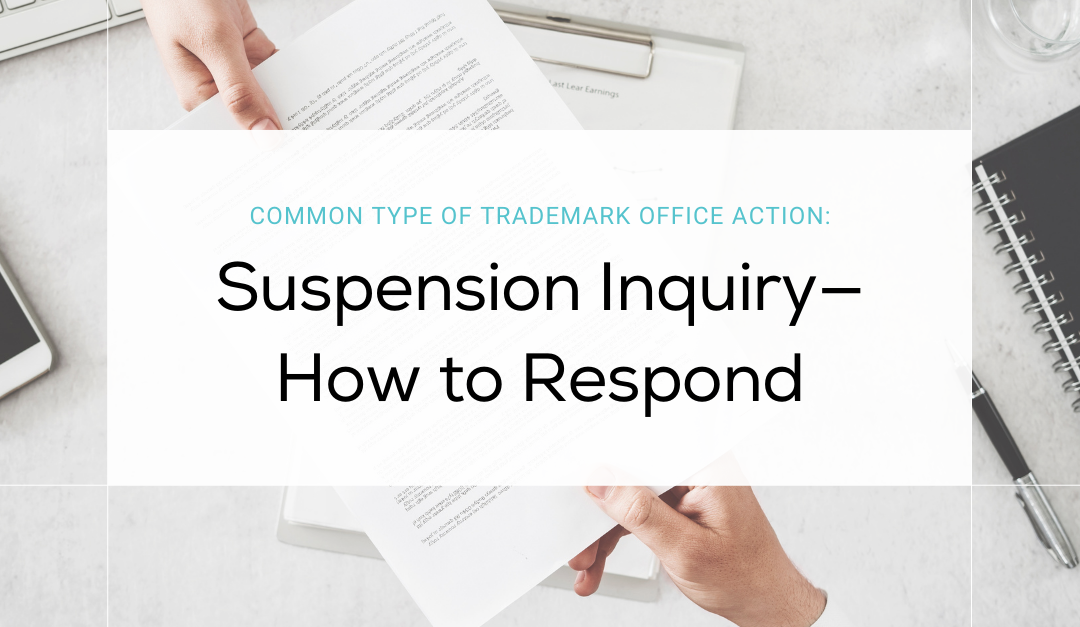When navigating the trademark application process, there are several steps along the way where the United States Patent and Trademark Office (USPTO) may reach out to you for additional information or clarification. One of these instances is when you receive a Suspension Inquiry. Understanding what this inquiry is, why it happens, and how to respond can make a significant difference in the trajectory of your trademark application.
What Is a Suspension Inquiry?
A Suspension Inquiry is issued by the USPTO’s examining attorney when your trademark application has been in a suspended state for an extended period—typically over six months. The reason for suspension could be varied, but the most common scenario is when the application is dependent on another pending application or a legal proceeding. During this suspension, the examining attorney periodically checks for updates to see if the reason for suspension has been resolved.
However, if the USPTO does not have enough information or needs further clarification regarding your case, they will issue a Suspension Inquiry. This inquiry is essentially a request for more details to help the examining attorney assess whether the suspension should continue or if the application can move forward. For the applicant, this request signals that the USPTO is actively monitoring the status of the application and is seeking clarification to make an informed decision.
Why Would You Receive a Suspension Inquiry?
You might receive a Suspension Inquiry for several reasons, such as:
• Pending Applications or Legal Proceedings: Your trademark might have been suspended because it is similar to another pending application or is involved in a legal proceeding. The USPTO will need additional information to determine if and when the application can move forward.
• Unavailability of Information: Sometimes, information relevant to your application, such as certain records in the USPTO database, might not be up-to-date or accessible. In such cases, the examining attorney might request that you provide the necessary details.
• Extended Suspension Period: If your application has been in suspension for an extended period without resolution, the USPTO will want to ensure that the application is still relevant and has not been abandoned. A Suspension Inquiry allows the examining attorney to confirm that the suspension should remain in place or that the application can proceed.
How to Respond to a Suspension Inquiry
Responding to a Suspension Inquiry is crucial for keeping your trademark application on track. Here are a few steps to guide you:
1. Timely Response
It is vital to respond within the specified timeframe. For most applicants, the response must be submitted within three months of receiving the inquiry. If you applied through the Madrid Protocol (an international treaty allowing trademark applicants to file in multiple countries simultaneously), you have six months to respond. Keep in mind that no extensions are allowed, so it’s critical to act quickly to avoid the risk of abandonment. Failing to respond in time will result in your application being considered abandoned, meaning you would lose your filing date and have to start the application process over from scratch.
2. Provide the Necessary Information
The USPTO’s Suspension Inquiry will specify exactly what information or clarification is required. This may include details about other pending trademark applications, documents from legal proceedings, or specific records that the USPTO cannot access. Ensure that you provide complete and accurate information to avoid any delays or further requests from the examining attorney. The goal is to make sure the attorney has everything they need to move forward with assessing your application.
3. Work With Your Attorney
Trademark law can be complex, and the language in the USPTO’s Suspension Inquiry may be technical or unclear to those unfamiliar with the process. It is highly recommended that you consult with your trademark attorney to craft a thorough and appropriate response. A knowledgeable attorney will ensure that all necessary information is submitted, and they can advise you on the best strategy to keep your application in good standing. Moreover, having a legal team manage the inquiry can provide you peace of mind and reduce the risk of errors or missteps.
The Importance of Addressing a Suspension Inquiry
A Suspension Inquiry may feel like an added complication to an already long process, but it’s important to view it as an opportunity. The inquiry offers a chance to clarify any lingering issues or misunderstandings, which can ultimately help move your trademark application forward. Failing to respond in a timely manner, or providing incomplete information, could result in significant delays or the abandonment of your application altogether.
Additionally, responding promptly demonstrates to the USPTO that you are actively engaged in the process and are committed to protecting your trademark rights. The faster you provide the necessary information, the sooner the examining attorney can make a decision on whether to continue the suspension or allow your application to proceed.
Conclusion
Trademark applications often face roadblocks along the way, and a Suspension Inquiry is just one of the many types of requests that the USPTO may issue during the examination process. Although it may seem like a bureaucratic hurdle, addressing the inquiry swiftly and comprehensively is key to keeping your application moving forward. By responding within the required timeframe and providing accurate information, you ensure that the USPTO can assess the status of your application and determine the next steps.
If you receive a Suspension Inquiry, don’t hesitate to consult with your legal team for guidance on how to respond effectively. Your attorney can help you navigate the inquiry and maintain the momentum of your application, keeping you one step closer to securing your trademark rights.
If you need assistance responding to a Suspension Inquiry or any other trademark-related issues, our team at Lengea Law is here to help.


